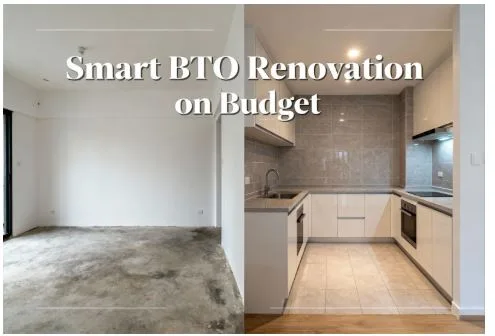Smart Budgeting Tips for Your First BTO Renovation in Singapore
Getting the keys to your Build-To-Order flat is thrilling. I still remember walking into mine three years ago – bare cement floors, plain white walls, and that distinct smell of fresh paint. The excitement quickly mixed with anxiety when I realized how much work lay ahead.
Property prices aren’t getting any cheaper in Singapore, and after stretching your budget for the down payment, renovation costs can feel like another mountain to climb. But here’s what I’ve learned from my own experience and talking to dozens of fellow BTO owners: smart planning makes all the difference.
What You’re Actually Starting With
Your BTO isn’t completely empty – there’s basic stuff already installed. You’ll find standard kitchen cabinets, basic bathroom fittings, and cement screed covering all the floors. The walls come painted, usually in that builder’s white that nobody really loves.
Here’s the thing though: most people end up changing almost everything. Those basic kitchen cabinets? They’re functional but pretty bare-bones. The bathroom fixtures work fine, but they’re not exactly what you’d call stylish. And those cement floors? You’ll definitely want proper flooring on top of them.
This gives you total freedom to design your space exactly how you want it. The flip side? Every choice costs money, and those decisions add up faster than you’d expect.
Where Your Money Actually Goes
When I started budgeting my renovation, I thought it was just about materials and labour. Wrong. There’s so much more hiding in the fine print.
You need permits from HDB – that costs money and takes time. Delivery fees for materials can run into hundreds of dollars depending on how much stuff you’re ordering. Then there’s disposal – all that construction debris has to go somewhere, and contractors charge for that. Don’t forget protection work either. If you’re doing floors, they’ll need to protect your kitchen cabinets and door frames from damage.
Flooring alone varies wildly depending on your flat size. A two-room flat needs way less than a five-room unit, obviously. But tile quality matters too. You can get basic ceramics for cheap, or spend significantly more on imported tiles that look like marble or wood. The labor costs stay relatively similar, but the material costs? That’s where you see huge differences.
The HDB website has clear guidelines about what renovation work needs approval. I’d recommend reading through that before you start – it helps avoid nasty surprises later. Getting rejected and having to reapply delays everything.
Why Packages Sometimes Make Sense
I initially wanted to hire different contractors for different jobs – figured I’d save money that way. My uncle, who’s been through three renovations, talked me out of it. He was right.
Nowadays, many contractors bundle everything together. These BTO renovation package deals from companies like V3 Contract often work out cheaper than doing things piecemeal. Why? The contractor can plan their workflow better, buy materials in bulk, and coordinate everything without waiting on other trades.
But you can’t just look at the price tag and sign. I learned this the hard way after almost choosing a package that seemed like a steal. Dig into what’s actually included. Are they handling the HDB permit application? Is cleaning included after they’re done? What about warranty – do you get any coverage if something goes wrong?
Some packages say “flooring included” but don’t cover the floor screeding underneath. Others might skip protective covering for your existing fixtures. You end up paying extra for these “small things” that aren’t so small when the bill comes.
Timing Your Renovation Strategically
Peak renovation periods typically align with major BTO handover cycles. Booking contractors during off-peak months can sometimes yield better rates and faster completion times. However, this needs balancing against your own moving timeline and any temporary accommodation costs.
Material costs fluctuate based on supply chain factors and import prices. While you can’t control global markets, staying informed about general price trends helps you time major purchases more strategically. Some contractors offer price guarantees once you sign the contract, which protects you from mid-project increases.
Common Budget Pitfalls to Avoid
Scope creep represents one of the biggest budget killers in renovation projects. That additional cabinet here, upgraded tile there – these decisions add up quickly. Establish your must-haves versus nice-to-haves before meeting contractors, and stick to your priorities.
Hidden costs often emerge in older resale flats, but BTO units are relatively predictable. Still, you might encounter unexpected expenses if you decide mid-project to upgrade fixtures or change design elements. Building a 10-15% contingency buffer into your budget provides breathing room for these situations.
Choosing materials solely based on initial cost without considering durability can lead to higher long-term expenses. Premium waterproofing, for instance, costs more upfront but prevents expensive water damage repairs down the line. The HDB’s Good Industry Practices guide emphasizes proper waterproofing standards that contractors should follow.
Maximizing Value Without Overspending
Focus your budget on elements that impact daily living and long-term property value. Quality flooring, effective storage solutions, and proper waterproofing in wet areas deliver returns far beyond their costs. These foundational elements affect your comfort and the flat’s resale potential.
Consider phased renovations if budget constraints are tight. Complete essential work first – flooring, kitchen, and bathrooms – then tackle aesthetic upgrades like feature walls or custom lighting later when finances allow. This approach lets you move in sooner while spreading costs over time.
Generic materials often perform just as well as branded alternatives for certain applications. That said, some items justify premium spending. Sanitary fittings, water pipes, and electrical components should never be compromised, as failures create significant inconvenience and repair costs.
Working With Contractors Effectively
Get detailed quotations from at least three contractors before deciding. These quotes should itemize all work, materials, timelines, and payment schedules. Vague quotations often lead to disputes later, so insist on specificity.
Communication sets the tone for your entire renovation journey. Establish clear expectations about site visits, progress updates, and how changes will be handled. Document all agreements in writing, even minor modifications to the original scope.
Payment schedules typically follow project milestones rather than upfront lump sums. This structure protects both parties and ensures work quality remains consistent throughout the project. Never make full payment before completion and your satisfaction with the finished work.
Final Thoughts
Your BTO renovation represents a significant investment in your future home and lifestyle. While budget considerations matter enormously, the cheapest option rarely delivers the best long-term value. Balance cost-consciousness with quality expectations, and don’t rush the decision-making process.
Take time to research materials, compare contractor offerings, and clarify exactly what each package includes. Your renovation should reflect your needs and preferences while remaining financially sustainable. With careful planning and smart choices, you can create a beautiful home that works within your budget and serves you well for years to come.




